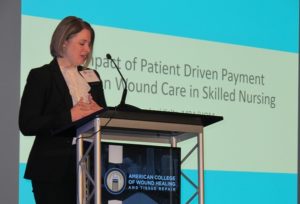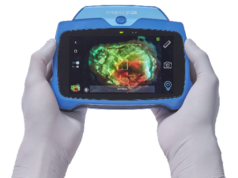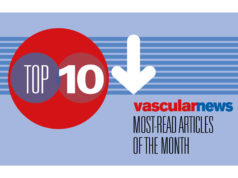
US wound care service providers operating in skilled nursing facilities were urged to follow a new set of steps when attending to patients amid a new billing system adopted by the Centers for Medicare and Medicaid Services (CMS), according to a talk given by Laci Keltz (Healogics, Lubbock, Texas, USA) at the annual meeting of the American College of Wound Healing and Tissue Repair (ACWHTR 2019; 11-12 October, Chicago, USA).
Keltz, an area vice president with the wound care centre group, was delivering a presentation on changes to the sub-acute payment model initiated by CMS on 1 October, switching from the resource utilization groups, version IV (RUG-IV) system to the patient-driven payment model (PDPM).
Under the new CMS paradigm, the timeliness with which providers first attend to patients is critical, she told the meeting. “As a wound care service provider in this skilled setting, probably the best thing that you can do to partner with the facility where you are providing services is to ensure that you get to see that patient in the first eight days of their admission and also take steps to make sure that your diagnosis does match and your documentation supports the diagnosis that they have given because it can impact the reimbursement that the facility receives,” Keltz said.
She outlined the principal changes to the payment model that impact wound care providers. While under the old system, facilities would receive a per diem rate determined by the skilled services administered to a patient, under PDPM the rate is determined by the individual’s medical needs. Second, the new model demands fewer assessments. “Under RUG-IV, the assessments are more frequent, required at days five, 14, 30, 60 and 90,” Keltz said.
“Under the new system, however, there are only two assessments that are required by CMS: The first being the initial five-day assessment and the second being the discharge assessment.” With both payment systems, there is a provision for optional unscheduled assessments when a change occurs in a patient’s condition. However, in the case of PDPM, continued Keltz, “CMS has given the guidance that you can only submit the interim payments assessment if there is a change of condition.”
She added: “There is not a lot of guidance on what would qualify as a change of condition, but there does have to be one if we are to submit that new assessment—not just that the facility misdiagnosed the patient when they were admitted.”
Finally, Keltz outlined the impact of a penalty imposed in the event of late submission. “Any patient who has not had their assessment submitted within those first eight days, the facility will have to take on this late penalty,” she said. “They only receive a base rate for providing care in those first eight days. Say on day 10, they submit. For days 1-9, the facility would get the base rate, and for day 10 get paid the full rate.”
In summary, Keltz emphasised that there are fewer opportunities to get the assessment correct, “so your facilities really want you to confirm that their diagnosis is, first, correct but also that it matches your diagnosis and their documentation. For residents with wounds that are present at admission, your ability to see that patient within those first eight days really is critical, not only to the facility’s ability to submit their assessment to CMS in a timely manner, but also to ensure that it is correct and therefore justifiable under the tool.”
This all amounts to a large impact on those operating in a skilled nursing setting, Keltz said, suggesting a point-by-point process recommendation to follow.
First, the facility should be asked to pull the wound diagnosis: “Too often we are missing this step,” she explained. “Essentially, they are submitting the incorrect diagnosis, which if it is a pressure ulcer could have negative consequences for the facility if that wound worsens, but also to make sure the documentation was the same.”
Then, the facility’s diagnosis must match the one provided, Keltz went on. The final step would entail taking action to correct the discrepancy with supporting notes from a physician. Keltz reminded providers that the PDPM model, made up of a base rate and a case mix of five components, two of which include wound care services, applies to the reimbursement of the facility, not the payment for the services they provide.












